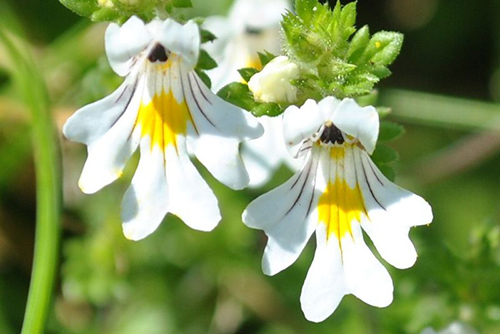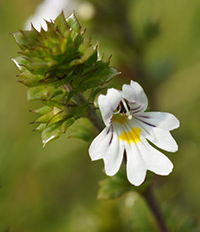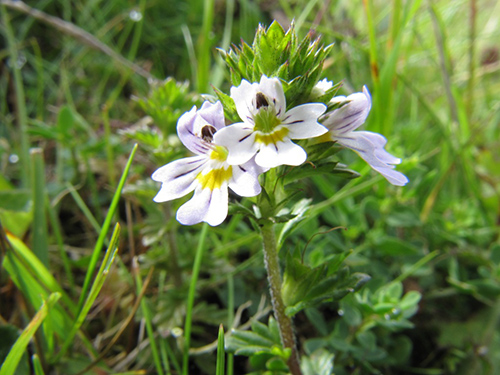Contents
The red eyebright plant has been used since the Middle Ages and onwards to heal conjunctivitis, blepharitis (inflammation of the eyelids), superficial keratitis (inflammation of the cornea), and eye tearing. Washing sleepy eyes with the red eyebright plant renders satisfactory results. Besides cleansing secretions, it reduces inflammation and dries the conjunctiva.

Red Eyebright Plant Scientific Facts
- Other names: Euphrasia, eyebright.
- French: Euphraise, euphraise officinale.
- Spanish: Eufrasia, eufrasia officinal.
- Environment: It is naturalized to the American continent and is found in mountain forests, meadows, and pastures all over Europe.
- Description: This is an annual herb in the Scrophulariaceae family that grows from 10 to 30 cm high. Its flowers are white with purple lines, and two lips form the corolla. It is a parasite that feeds on the roots of other plants.
- Parts of the plant used medicinally: The entire plant.

Healing Properties
The plant contains the glycoside substance aucubine and tannins, phenolic acids, flavonoids, vitamins A and C, and traces of essences. It has antiseptic, anti-inflammatory, and astringent properties, mainly effective on the conjunctival mucosa.
It is also applied as gargles and mouth rinses in cases of stomatitis (inflammation of the oral mucosa) and pharyngitis and is in nasal irrigations for rhinitis (internal nasal inflammation).
Eyebright is one of the single best herbs for the eyes. To treat all eye conditions, drink eyebright tea liberally and daily. It helps clear the blood, stimulate the liver, and relieve all disorders affecting vision clarity. The plant also relieves discomfort from minor eye irritations and eyestrains. Itchy and/or watery eyes can also be treated with this herb.
Red eyebright has detoxifying and cooling properties that enable it to combat inflammation. It can also treat inflammation of the throat and nose. The plant is also helpful in treating nose and throat congestion, upper respiratory problems, indigestion, impure blood, hay fever, cataracts, diabetes, and allergies. In external applications, eyebright can be used as an eyewash to treat other eye diseases, burning and sore eyes, ophthalmia, eye weakness, and conjunctivitis, which can be more effective if combined with rue, fennel, or goldenseal. The infusion can be made using one ounce of the herb to a pint of boiled water and steeped for twenty minutes. You can make a tea beverage using ½ ounce herb steeped in a pint of water.
How to use Red Eyebright

- Infusion
- Eye irrigation. Let the liquid drop from the outside inwards, from the temple to the nose. Eye baths should be done mainly in the morning.
- Eyedrops. 5-10 drops in each eye, four times a day.
- Gargles and rinses. In cases of oral or pharyngeal conditions.
- Nasal irrigations are used in case of rhinitis or coryza.
Infusion: Steep for five to fifteen minutes and take six ounces frequently. Tincture: Take thirty to sixty drops regularly. Fluid Extract: Take one teaspoon regularly. Powder: Take ten #0 capsules (60 grains) regularly.
DISCLAIMER: All content on this website is presented solely for educational and informational objectives. Do not rely on the information provided as a replacement for advice, diagnosis, or treatment from a qualified medical expert. If you are pregnant, nursing, or have any preexisting medical concerns, talk to your doctor before using any herbal or natural medicines.
REFERENCES
- George D. Pamplona-Roger, M.D. “Encyclopedia of Medicinal Plants.” George D. Pamplona-Roger, M.D. Encyclopedia of Medicinal Plants. Ed. Francesc X. Gelabert. Vols. 1 San Fernando de Henares: Editorial Safeliz, 2000. 136. Print.
- Vance Ferrell Harold M. Cherne, M.D. The Natural Remedies Encyclopedia [Book]. – Altamont, TN: Harvestime Books, 2010. – Vol. Seventh Edition: 7: pp. 157.
- https://www.ncbi.nlm.nih.gov/pmc/articles/PMC4115993/
- https://www.ncbi.nlm.nih.gov/pmc/articles/PMC3863924/
